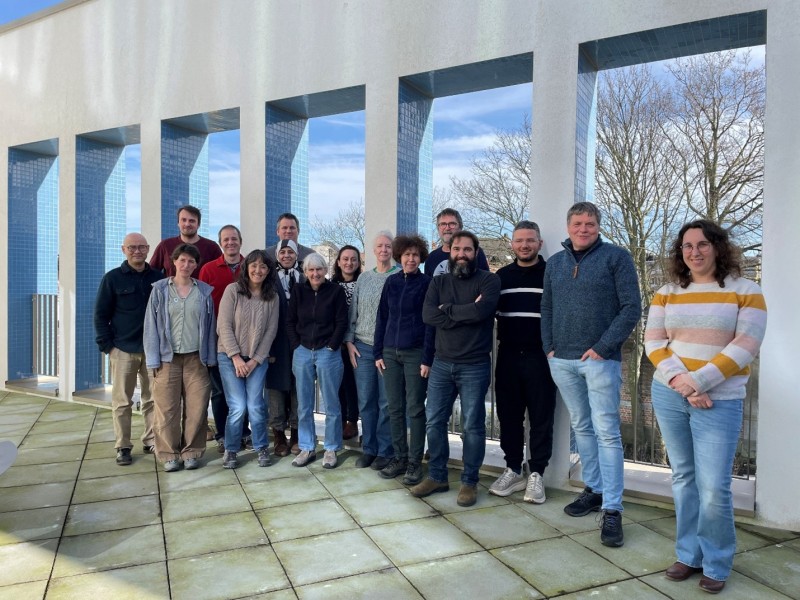News
Cnidaria editors participated in the very first WoRMS Cnidaria Workshop
Added on 2024-05-22 17:14:04 by Dekeyzer, Stefanie
From February 27-29 2024, editors and experts on Cnidaria convened in Ostend to enhance the data and capabilities of their portals and pages in WoRMS.This workshop provided an opportunity to connect across the editor and expert community for Cnidaria with the broad goal of making WoRMS a more useful and coherent resource for the research community. This was the first opportunity for Cnidaria editors to coordinate and prioritize their efforts. Specific goals were to update the higher-level taxonomy of Cnidaria within WoRMS, add locality (geographic and bathymetric) data as both point data and zonation attributes, and identify priority trait data to be implemented for Cnidaria. Planned near-term outcomes are a “status report” that highlights diversity and taxonomy of Cnidaria and a nascent trait database for species-level attributes of broad interest and ecological relevance.
Comprising approximately 12,000 known, valid species, Cnidaria is among the oldest lineages of animals. Canonically considered to represent two major lineages—the exclusively polypoid Anthozoa and the biphasic Medusozoa—Cnidaria is now recognized to also include Myxozoa, microscopic endoparasites previously classified among unicellular eukaryotes. The WoRMS resources for Cnidaria include lineage-specific portals for Actiniaria, Hydrozoa, and Scleractinia. Species like the hydrozoan Hydra and the sea anemone Nematostella are long-standing and important model systems for cellular and developmental biology. Corals, a common name that is used for members of diverse lineages within Cnidaria, are ecologically critical as habitat anchors in reef ecosystems and of conservation concern in light of anthropogenic threats. In addition to enriching WoRMS with more comprehensive geographic and ecological data, workshop participants identified species traits and attributes significant to scientific and conservation priorities for addition to the WoRMS trait database, pending feedback from the WoRMS Steering Committee and Data Management Team.
Key actions at the workshop included revising the phylum-level taxonomy, addition and update of 90 taxa, 53 distributions (of which 8 type localities), 70 specimens, 758 traits and attributes, and 13 notes.
The organization of the workshop and the support of the Data Management Team (DMT) are supported by LifeWatch Belgium, part of the E-Science European LifeWatch Infrastructure for Biodiversity and Ecosystem Research. LifeWatch ERIC is a distributed virtual laboratory, which is used for different aspects of biodiversity research. The Species Information Backbone of LifeWatch aims at bringing together taxonomic and species-related data and at filling the gaps in our knowledge. In addition, it gives support to taxonomic experts by providing them logistic and financial support for meetings and workshops related to expanding the content and enhancing the quality of taxonomic databases.
The report of this workshop is available through the link below.
Image: Group picture of workshop. Top row (left to right): Henry Choong, Ben Boydens, Frederic Sinniger, Bart Vanhoorne, Mona Goharimanesh, Meg Daly, Tina Molodtsova, Wim Decock, Kaveh Samimi-Namin, Paris Stefanoudis, Bert Hoeksema, Stefanie Dekeyzer. Bottom row (left to right): Leen Vandepitte, Paulyn Cartwright, Lynn Delgat, Cathy McFadden.

Comprising approximately 12,000 known, valid species, Cnidaria is among the oldest lineages of animals. Canonically considered to represent two major lineages—the exclusively polypoid Anthozoa and the biphasic Medusozoa—Cnidaria is now recognized to also include Myxozoa, microscopic endoparasites previously classified among unicellular eukaryotes. The WoRMS resources for Cnidaria include lineage-specific portals for Actiniaria, Hydrozoa, and Scleractinia. Species like the hydrozoan Hydra and the sea anemone Nematostella are long-standing and important model systems for cellular and developmental biology. Corals, a common name that is used for members of diverse lineages within Cnidaria, are ecologically critical as habitat anchors in reef ecosystems and of conservation concern in light of anthropogenic threats. In addition to enriching WoRMS with more comprehensive geographic and ecological data, workshop participants identified species traits and attributes significant to scientific and conservation priorities for addition to the WoRMS trait database, pending feedback from the WoRMS Steering Committee and Data Management Team.
Key actions at the workshop included revising the phylum-level taxonomy, addition and update of 90 taxa, 53 distributions (of which 8 type localities), 70 specimens, 758 traits and attributes, and 13 notes.
The organization of the workshop and the support of the Data Management Team (DMT) are supported by LifeWatch Belgium, part of the E-Science European LifeWatch Infrastructure for Biodiversity and Ecosystem Research. LifeWatch ERIC is a distributed virtual laboratory, which is used for different aspects of biodiversity research. The Species Information Backbone of LifeWatch aims at bringing together taxonomic and species-related data and at filling the gaps in our knowledge. In addition, it gives support to taxonomic experts by providing them logistic and financial support for meetings and workshops related to expanding the content and enhancing the quality of taxonomic databases.
The report of this workshop is available through the link below.
Image: Group picture of workshop. Top row (left to right): Henry Choong, Ben Boydens, Frederic Sinniger, Bart Vanhoorne, Mona Goharimanesh, Meg Daly, Tina Molodtsova, Wim Decock, Kaveh Samimi-Namin, Paris Stefanoudis, Bert Hoeksema, Stefanie Dekeyzer. Bottom row (left to right): Leen Vandepitte, Paulyn Cartwright, Lynn Delgat, Cathy McFadden.

[Overview] [Login]